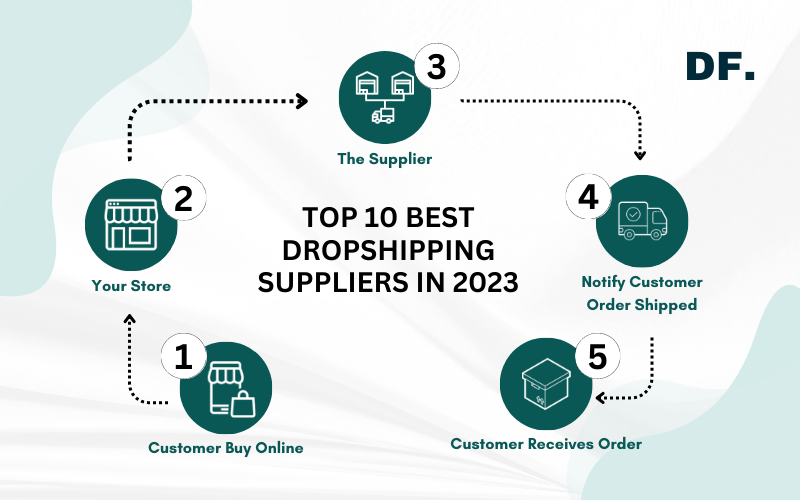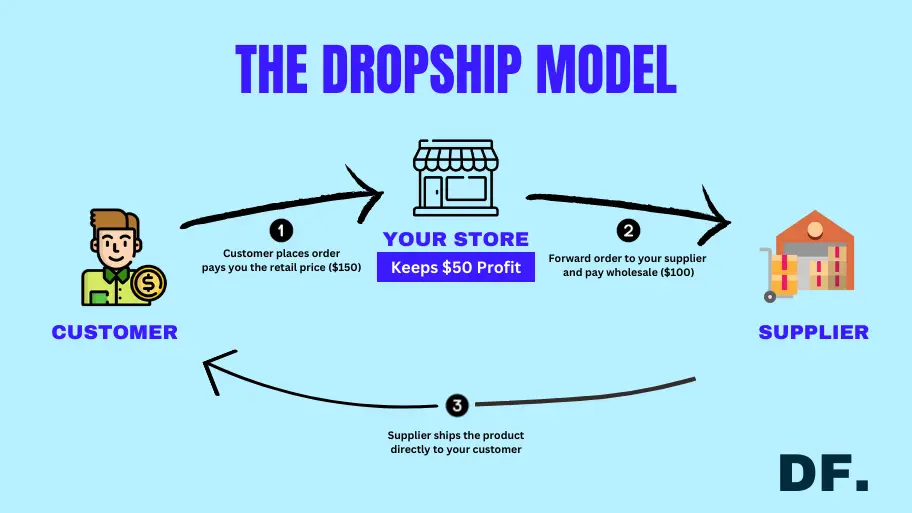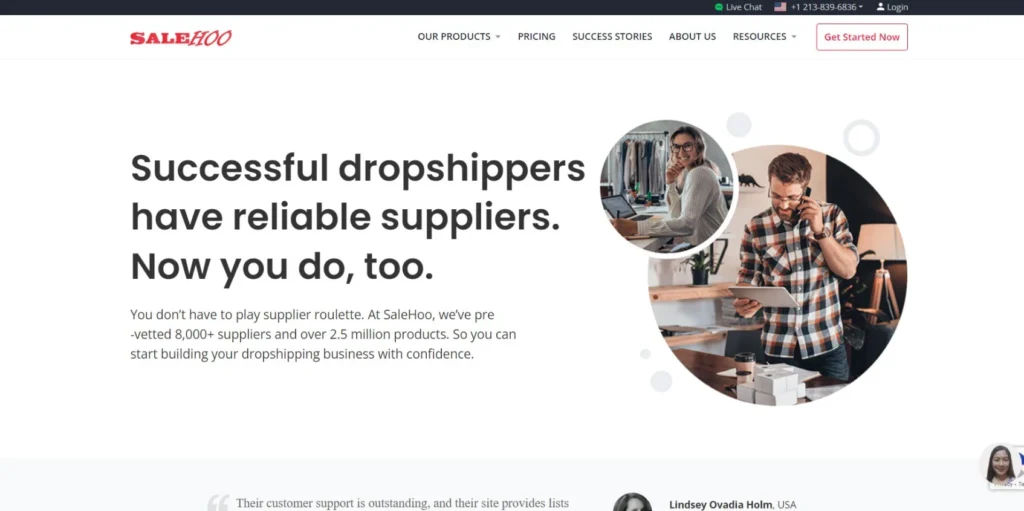Top 10 Best Dropshipping Suppliers in 2023

Setting the stage for dropshipping success, let’s delve into the pivotal role of suppliers in the business model and discover strategies to navigate the challenges of supplier selection.
In the realm of dropshipping, where entrepreneurs venture into the e-commerce landscape with minimal upfront investment, suppliers play a paramount role. These unsung heroes are the backbone of your business, responsible for the quality of products, timely deliveries, and overall customer satisfaction. To embark on a successful dropshipping journey, it’s imperative to understand the nuances of supplier selection. In this article, we’ll explore the best practices and platforms for finding the right dropshipping suppliers, ensuring your path to e-commerce prosperity.
What is dropshipping?
Dropshipping is a business model that enables entrepreneurs to sell products to customers without the need to manage inventory or handle the logistics of shipping. In a traditional retail business, merchants purchase products in bulk, store them, and then ship them to customers as orders are received. Dropshipping, on the other hand, eliminates the need for stocking inventory, making it an attractive option for those seeking a more streamlined and hands-off approach to e-commerce. Dropshipping is a Good Passive Income Method if You Want to Make Money Effortlessly
Understanding the Essence of Dropshipping Suppliers

Defining dropshipping suppliers: Key players in your business model
Dropshipping suppliers are the lifeblood of your e-commerce venture. Unlike traditional business models where you handle inventory, packaging, and shipping, dropshipping suppliers take on these responsibilities. They store products and fulfill orders on your behalf, allowing you to focus on marketing and customer engagement.
The benefits of a reliable supplier-customer relationship
A symbiotic relationship with a reliable supplier fosters trust and loyalty among your customers. Timely deliveries and quality products contribute to positive customer experiences, leading to repeat business and positive reviews.
Criteria for evaluating dropshipping suppliers
Choosing the right suppliers involves considering factors like product quality, communication responsiveness, shipping times, and pricing. It’s essential to define your evaluation criteria and prioritize them based on your business goals.
Here are the most important criteria to consider:
- Product Quality and Range: Choose a supplier known for high-quality products that align with your niche. A diverse product range gives you more options to offer to your customers.
- Reliability and Reputation: Look for suppliers with a solid track record of reliability. Check reviews, ratings, and references from other businesses to gauge their reputation.
- Communication and Responsiveness: Effective communication is key. Opt for suppliers who respond promptly to inquiries and provide clear information about products, shipping, and any potential issues.
- Shipping Times and Costs: Transparent shipping times and costs are crucial for customer satisfaction. Opt for suppliers who offer reasonable shipping rates and provide accurate delivery estimates.
- Dropshipping Integration: Ensure the supplier integrates well with your chosen e-commerce platform. Platforms like Shopify and WooCommerce offer integrations with specific suppliers, making order fulfillment smoother.
- Product Availability: Choose suppliers who maintain consistent product availability. Unreliable stock levels can lead to frustrated customers and lost sales.
- Pricing Structure: Consider the supplier’s pricing structure, including product costs, shipping fees, and any additional charges. Balance these costs with your desired profit margin.
- Minimum Order Quantities (MOQs): Be aware of any minimum order requirements set by the supplier. Make sure these align with your business’s budget and demand.
- Return and Refund Policies: Understand the supplier’s return and refund policies. Clear policies and easy return processes can enhance customer satisfaction and trust.
- Location and Shipping Options: Consider the supplier’s location relative to your target audience. Local suppliers might offer faster shipping times, while global suppliers can provide a wider product range.
- Supplier’s Terms and Conditions: Carefully review the supplier’s terms and conditions. Ensure they align with your business goals and operational needs.
- Samples and Testing: Request product samples to evaluate their quality firsthand. This helps you verify the accuracy of product descriptions and assess the overall customer experience.
- Dropshipping Experience: Opt for suppliers with experience in dropshipping. They understand the unique requirements of this business model and can provide better support.
- Payment Options: Choose suppliers with flexible payment options that suit your business’s needs. Ensure they offer secure payment gateways for hassle-free transactions.
- Customization and Branding: Some suppliers offer options for the customization or branding of products. This can help you create a unique and branded customer experience.
- Support and Customer Service: Excellent customer service from your supplier is essential. A responsive support team can address issues and resolve challenges quickly.
What are the best dropshipping suppliers?
1. AliExpress

AliExpress is a popular online retail platform owned by Alibaba Group. It offers a wide range of products, including those suitable for dropshipping. The platform connects buyers with suppliers, primarily based in China, and is known for its competitive prices and vast product selection.
Recommended for: Businesses seeking a vast selection of products at competitive prices. Suitable for entrepreneurs looking to start or expand their dropshipping ventures with a wide range of options.
2. Alibaba
Alibaba is a leading global wholesale trading platform. It connects businesses with suppliers, manufacturers, and wholesalers from around the world. It’s suitable for businesses looking to source products in bulk, and it also offers dropshipping options through some suppliers.
Recommended for: Businesses interested in sourcing products in bulk from manufacturers and wholesalers. Also suitable for those looking to explore dropshipping options through select suppliers on the platform.
3. SaleHoo

SaleHoo is a wholesale and dropshipping directory that connects businesses with verified suppliers. It offers a curated list of suppliers across various niches, along with tools and resources to help businesses succeed in dropshipping.
Recommended for: Entrepreneurs and businesses in need of a curated list of verified suppliers across various niches. Ideal for those seeking a comprehensive directory with resources to support successful dropshipping.
4. Worldwide Brands
Worldwide Brands is a directory of certified wholesalers and dropshippers. It provides access to a wide range of products from legitimate suppliers, making it a valuable resource for businesses looking to find reliable partners.
Recommended for: Businesses looking for certified wholesalers and dropshippers. Suitable for entrepreneurs who prioritize sourcing products from legitimate and reputable suppliers.
5. Doba
Doba is a dropshipping platform that aggregates products from various suppliers into one interface. It enables businesses to easily find products to sell without managing inventory or shipping logistics directly.
Recommended for: Entrepreneurs aiming for a simplified dropshipping experience. Perfect for those who want to access a wide array of products without managing inventory or shipping logistics.
6. Sunrise Wholesale
Sunrise Wholesale is a wholesale and dropshipping platform that offers a variety of products at competitive prices. It provides tools and services to help businesses streamline their dropshipping operations.
Recommended for: Businesses interested in a diverse range of products at competitive prices. Suitable for entrepreneurs looking to streamline their dropshipping operations with additional tools and services.
7. Wholesale2b
Wholesale2b is a dropshipping platform that offers a range of products across different categories. It provides integration with popular e-commerce platforms and offers a user-friendly interface for managing product listings.
Recommended for: Entrepreneurs seeking easy integration with popular e-commerce platforms. Ideal for those who want a user-friendly interface to manage product listings and streamline operations.
8. Megagoods
Megagoods is a dropshipping supplier that offers consumer electronics and gadgets. It focuses on providing a selection of products in the electronics niche for businesses to sell to their customers.
Recommended for: Businesses focused on consumer electronics and gadgets. Suitable for entrepreneurs looking to sell a selection of electronic products to their customers.
9. Wholesale Central
Wholesale Central is an online directory that connects businesses with wholesalers, distributors, and dropshippers. It features a wide range of product categories and provides a platform for businesses to find suppliers.
Recommended for: Entrepreneurs and businesses looking for a comprehensive online directory connecting them with wholesalers, distributors, and dropshippers across various categories.
10. Modalyst
Modalyst is a dropshipping platform that specializes in fashion and apparel products. It offers a curated selection of trendy items from various independent designers and brands.
Recommended for: Entrepreneurs interested in the fashion and apparel niche. Perfect for those who want access to a curated selection of trendy fashion items from different designers and brands.
11. Spocket
Spocket is a dropshipping platform that emphasizes sourcing products from suppliers located in the United States and Europe. It aims to provide fast shipping options and quality products for e-commerce businesses.
Recommended for: Businesses prioritizing faster shipping options and high-quality products. Ideal for those who prefer sourcing from suppliers in the United States and Europe.
12. CJDropshipping
CJDropshipping is a platform that offers dropshipping services, including sourcing products, order fulfillment, and customized packaging. It focuses on providing a seamless experience for businesses looking to start or scale their dropshipping operations.
Recommended for: Entrepreneurs seeking a comprehensive dropshipping solution. Suitable for businesses looking to outsource product sourcing, order fulfillment, and custom packaging.
13. CROV
CROV is a wholesale and dropshipping platform that offers a wide range of products across multiple categories. It provides tools and services to help businesses find products, connect with suppliers, and manage orders.
Recommended for: Entrepreneurs looking for a diverse range of products across multiple categories. Suitable for businesses interested in a platform that helps them find products, connect with suppliers, and manage orders.
These suppliers offer various benefits and cater to different niches and business models. When considering a supplier, it’s important to thoroughly research their offerings, terms, and reviews to ensure they align with your business needs and goals.
Finding Suppliers Tailored to Your Brand
In the world of dropshipping, targeting a specific niche market can set your business apart and create a unique value proposition for your customers. Niche markets allow you to cater to a specialized audience with distinct preferences and needs. Finding suppliers that align with your niche and brand identity is a pivotal step toward delivering exceptional products and experiences. Let’s explore the strategies for navigating niche markets and establishing partnerships with suppliers that resonate with your brand:
1. Defining Your Niche: Clarity is Key
Before seeking suppliers, define your niche with precision. Understand the unique characteristics of your target audience, their preferences, and their pain points. This clarity will guide your supplier search and ensure that the products you offer align closely with your niche’s demands.
Niche Definition Strategies:
- Market Research: Dive deep into market research to identify trends, gaps, and opportunities within your chosen niche.
- Audience Persona: Create detailed audience personas to gain insights into your customers’ preferences, behaviors, and buying patterns.
- Problem-Solution Alignment: Identify specific problems your niche audience faces and consider how your products can provide solutions.
Action: Create a clear and concise niche statement that encompasses the essence of your business and the unique value you bring to your target audience.
2. Supplier Alignment: Seeking Niche-Focused Partners
Once you’ve defined your niche, your next step is to find suppliers that specialize in the products your niche audience desires. Suppliers who understand your niche can provide products that meet the quality and style expectations of your customers.
Supplier Search Strategies:
- Niche-Specific Directories: Explore niche-specific supplier directories to discover suppliers who cater to your chosen market.
- Trade Shows and Exhibitions: Attend trade shows and industry exhibitions to connect with suppliers who focus on your niche.
- Online Marketplaces: Search online marketplaces that curate products within your niche, often featuring suppliers who understand niche markets.
Action: Reach out to potential suppliers and engage in discussions to assess their understanding of your niche and their ability to deliver products that resonate with your brand.
3. Quality Assurance: Ensuring Niche-Relevant Products
The products you offer must align seamlessly with your niche’s quality standards and expectations. Reliable suppliers should provide high-quality products that reflect your brand’s values and resonate with your target audience.
Quality Assurance Strategies:
- Sample Testing: Request product samples from potential suppliers to evaluate their quality, functionality, and alignment with your niche.
- Product Certification: Inquire about any certifications or quality standards associated with the products offered by the supplier.
- Customer Feedback: Consider suppliers with positive reviews and feedback from other businesses operating within your niche.
Action: Thoroughly review product samples and engage in quality discussions with potential suppliers to ensure that their offerings meet the expectations of your niche audience.
4. Brand Alignment: Shared Values and Vision
Creating a cohesive brand identity is essential for resonating with your niche audience. Seek suppliers who share your brand’s values, vision, and commitment to delivering products that align with your niche’s preferences.
Brand Alignment Strategies:
- Mission and Values: Choose suppliers whose mission and values align with your brand’s core principles.
- Ethical Practices: Consider suppliers that adhere to ethical sourcing, manufacturing, and environmental practices in line with your brand’s values.
- Customization Options: Explore suppliers that offer customization options to tailor products to your brand’s aesthetic and niche audience.
Action: Initiate conversations with potential suppliers to understand their approach to sustainability, ethical practices, and willingness to collaborate on brand customization.
Building Trust: Verifying Supplier Credibility and Reliability
In the world of dropshipping, building trust with your suppliers is a cornerstone of a successful and sustainable business. Verifying the credibility and reliability of your suppliers is essential to ensure smooth operations, high-quality products, and satisfied customers. By taking proactive steps to establish trust with your suppliers, you can forge strong partnerships that contribute to the growth and success of your dropshipping venture. Let’s delve deeper into the strategies for building trust with your suppliers:
1. Supplier Background Check: Digging into Their History
Before entering into a partnership, conduct a thorough background check on your potential suppliers. Research their history, reputation, and track record to gain insights into their credibility and reliability.
Research Strategies:
- Online Reviews and Ratings: Explore online platforms and forums to read reviews and ratings from other businesses that have worked with the supplier.
- References and Testimonials: Request references or testimonials from the supplier’s existing clients to gauge their satisfaction and experiences.
- Industry Associations: Check if the supplier is affiliated with industry associations or organizations, which can be indicative of their commitment to professionalism.
Action: Utilize search engines and online platforms to gather information about the supplier’s reputation and reliability. Approach references and testimonials with a list of questions that address your concerns.
2. Communication and Responsiveness: Assessing Engagement
Effective communication is a hallmark of trustworthy suppliers. Assess the supplier’s responsiveness, willingness to address your inquiries, and clear communication practices.
Communication Strategies:
- Initial Inquiry: Observe the supplier’s response time and the completeness of their answers when you make initial contact.
- Clarification and Follow-Up: Gauge their responsiveness and willingness to provide additional information when you seek clarification or request more details.
- Consistency: Analyze their consistency in communication patterns and their commitment to maintaining open lines of dialogue.
Action: Engage in a dialogue with potential suppliers and ask questions that test their responsiveness and willingness to engage. A supplier who communicates effectively is more likely to be reliable in the long run.
3. Sample Testing: Evaluating Product Quality
To establish trust in the quality of the products they offer, request samples from potential suppliers. Testing samples allows you to evaluate the accuracy of product descriptions, materials, and overall quality.
Sample Testing Strategies:
- Product Comparison: Compare the received samples with product descriptions on the supplier’s website to ensure accuracy.
- Quality Assessment: Assess the product’s durability, functionality, and overall quality to ensure they meet your standards.
- Packaging and Presentation: Evaluate the packaging and presentation of the sample, as these factors contribute to the customer experience.
Action: Request samples from suppliers and conduct a thorough evaluation. Share your feedback with the supplier, noting any discrepancies or areas for improvement.
4. Transparent Terms and Policies: Clear Business Agreements
Transparency in business agreements and terms is a key element of trust-building. Clearly define terms, conditions, and expectations with your suppliers to prevent misunderstandings.
Transparency Strategies:
- Contract Review: Review contracts, terms of service, and any written agreements with the supplier to ensure clarity and alignment.
- Expectation Setting: Clearly communicate your expectations, including pricing, shipping times, returns, and customer service standards.
- Dispute Resolution: Discuss how potential disputes will be handled and resolved, fostering transparency and accountability.
Action: Engage in open discussions with potential suppliers about your expectations and inquire about their policies. Seek clarity on any terms that require further explanation.
Negotiating Win-Win Deals: Pricing, Discounts, and MOQs
Negotiation is a valuable skill in the world of dropshipping, enabling you to secure favorable terms with your suppliers and enhance your profit margins. As you embark on your dropshipping journey, mastering the art of negotiation can lead to win-win outcomes for both you and your suppliers. Let’s delve deeper into the strategies for negotiating pricing, securing discounts, and navigating Minimum Order Quantities (MOQs) to optimize your business’s financial health:
1. Pricing Negotiation: Balancing Profit and Cost
Negotiating pricing with your suppliers is a fundamental aspect of your dropshipping business. Striking the right balance between your profit margin and competitive pricing is essential to attract customers while ensuring a sustainable income for your business.
Negotiation Strategies:
- Research and Benchmarking: Understand the market average for the products you’re selling. This empowers you with data to negotiate from a position of knowledge.
- Bundle Purchases: Consider negotiating better prices by agreeing to purchase a bundle of products or a larger quantity at once.
- Long-Term Partnerships: Express your interest in a long-term partnership with the supplier. This commitment might lead to more favorable pricing terms.
Action: Approach negotiations with a collaborative mindset. Discuss your business goals and how a mutually beneficial pricing arrangement can be reached.
2. Discounts and Special Offers: Increasing Competitiveness
Securing discounts from suppliers can give you a competitive edge, allowing you to offer attractive prices to your customers. Special offers, seasonal discounts, or bulk purchase discounts can enhance customer loyalty and drive sales.
Negotiation Strategies:
- Volume Discounts: If you’re confident in selling a large volume of products, negotiate for volume-based discounts that reward your commitment.
- Promotional Agreements: Propose promotional activities (such as featuring the supplier’s products prominently on your website) in exchange for discounts.
- Clear Communication: Clearly communicate your intentions and expectations regarding discounts, ensuring both parties are on the same page.
Action: Establish a clear understanding of the terms and conditions associated with discounts. Document any agreements in writing to avoid misunderstandings in the future.
3. Minimum Order Quantities (MOQs): Finding the Right Balance
MOQs are the minimum number of products a supplier requires you to order. While MOQs can offer cost advantages, they can also pose challenges if not managed effectively.
Negotiation Strategies:
- Negotiate MOQ Flexibility: Discuss with suppliers the possibility of lowering MOQs, especially for newer products or when you’re testing the market.
- Incremental Ordering: If the supplier insists on a higher MOQ, consider negotiating a gradual increase in order quantity as your business grows.
- MOQ Variations: Inquire if the supplier offers different MOQ tiers based on the products or variations within a product line.
Action: Evaluate whether the potential savings from meeting MOQs align with your business’s cash flow and sales projections. Carefully analyze the demand for each product before committing to higher quantities.
Technological Integration: API, Automation, and Inventory Management
In the dynamic world of dropshipping, staying ahead often requires harnessing the power of technology. Embracing technological integration through Application Programming Interfaces (APIs), automation, and effective inventory management can streamline your operations, enhance customer experiences, and contribute to the overall efficiency of your dropshipping business. Let’s delve into these key aspects and discover how they can propel your business forward:
1. Application Programming Interfaces (APIs): Enhancing Connectivity
APIs serve as digital bridges, enabling systems to communicate and share information seamlessly. In dropshipping, APIs connect your online store with your suppliers’ systems, facilitating real-time data exchange. This connectivity transforms the way you manage orders, inventory, and updates, leading to smoother operations and improved customer satisfaction.
Benefits of API Integration:
- Real-Time Order Processing: Orders placed on your website can be automatically transmitted to the supplier for processing, reducing manual data entry and human errors.
- inventory Synchronization: APIs ensure that your inventory levels are updated in real-time. This prevents overselling and minimizes the risk of disappointing customers with out-of-stock products.
- Automated Tracking: Customers can receive automatic shipping notifications and tracking information as soon as an order is fulfilled.
Action: Research your chosen e-commerce platform and supplier to determine the availability of APIs. Consult with technical experts if needed to ensure successful integration.
2. Automation: Streamlining Operations
Automation is a game-changer in dropshipping, allowing you to automate repetitive tasks and allocate your time and resources to strategic activities. From order processing to customer communication, automation can significantly enhance your business’s efficiency.
Areas for Automation:
- Order Fulfillment: Automatically forward orders to suppliers for processing and tracking.
- Inventory Updates: Keep your inventory levels accurate across platforms without manual intervention.
- Customer Notifications: Send order confirmations, shipping updates, and tracking information automatically.
- Email Marketing: Automate email campaigns to engage customers and drive repeat business.
Benefits of Automation:
- Time Savings: Automation frees up time, enabling you to focus on growing your business rather than handling routine tasks.
- Consistency: Automation ensures that processes are executed consistently, reducing the risk of errors.
- Scalability: As your business grows, automation helps you handle higher order volumes without overwhelming your resources.
Action: Explore automation tools and software solutions that integrate seamlessly with your chosen e-commerce platform. Experiment with automation in stages, starting with basic tasks and gradually expanding.
3. Inventory Management: Keeping Track of Stock
Effective inventory management is vital in dropshipping to prevent overstocking or running out of popular items. Technology plays a crucial role in helping you maintain a balanced inventory and meet customer demands efficiently.
Inventory Management Strategies:
- Real-Time Tracking: Utilize technology to monitor inventory levels in real time across all platforms.
- Set Alerts: Implement automated alerts when products reach a certain threshold, prompting you to restock or adjust pricing.
- Forecasting: Use historical data and sales trends to anticipate demand and adjust your inventory accordingly.
- Supplier Integration: Connect with suppliers’ inventory systems to receive accurate updates on product availability.
Benefits of Effective Inventory Management:
- Optimized Stock Levels: Maintain the right amount of stock to fulfill orders without excess inventory costs.
- Improved Customer Satisfaction: Accurate inventory data helps prevent out-of-stock surprises, leading to happier customers.
- Reduced Holding Costs: Minimize storage costs by managing inventory efficiently and avoiding unnecessary stockpiling.
Action: Explore inventory management software and tools that sync with your e-commerce platform and suppliers’ systems. Regularly analyze sales data and adjust your inventory strategy based on changing market trends.
Red Flags and Warning Signs: Identifying and Avoiding Unreliable Suppliers
When venturing into the world of dropshipping, choosing the right suppliers is critical to your business’s success. While there are many reputable and trustworthy suppliers out there, it’s important to be vigilant and aware of potential red flags that could indicate unreliability. By learning how to spot these warning signs, you can avoid potential pitfalls and forge partnerships that will help your dropshipping business thrive. Here’s a closer look at some key red flags and how to navigate them:
1. Inconsistent Communication
Communication is the cornerstone of any successful business relationship. If a supplier is slow to respond to your inquiries, fails to provide clear and timely information, or exhibits inconsistent communication patterns, it could be a sign of trouble. Reliable suppliers understand the importance of transparent communication and are committed to maintaining open lines of dialogue.
Action: Reach out to the supplier with questions or concerns and assess their response time and the quality of their communication. If communication remains inconsistent or unsatisfactory, consider exploring alternative supplier options.
2. Delayed Shipments and Backorders
Timely order fulfillment is crucial in dropshipping. If your chosen supplier consistently experiences delays in shipping orders or frequently informs you of backorders (when items are out of stock after you’ve placed an order), it can negatively impact your customer experience and brand reputation.
Action: Inquire about the supplier’s average processing and shipping times. Discuss their procedures for handling out-of-stock items and how they manage backorders. If delays are a recurring issue, it may be best to seek more reliable suppliers.
3. Lack of Transparency
Transparent business practices are indicative of trustworthy suppliers. If a supplier is hesitant to share crucial information, such as their manufacturing processes, product sources, or shipping methods, it could raise concerns about the authenticity of their products and their commitment to your partnership.
Action: Ask detailed questions about the supplier’s operations, sourcing methods, and quality control processes. A reputable supplier will be forthcoming with information that demonstrates their legitimacy and commitment to providing high-quality products.
4. Negative Reviews and Poor Ratings
Online reviews and ratings can offer valuable insights into a supplier’s reputation. If you come across a consistent pattern of negative feedback, complaints about product quality, or unresolved customer issues related to a particular supplier, it’s a sign that their reliability may be questionable.
Action: Research the supplier’s online presence and read reviews from other dropshippers who have worked with them. Consider the nature of the complaints and the supplier’s response to them. If negative feedback is prevalent, it’s wise to proceed with caution or explore alternative options.
5. Unrealistic Promises and Pricing
Be wary of suppliers who make promises that seem too good to be true. If a supplier offers exceptionally low prices that don’t align with the market average, or if they guarantee instant success and astronomical profits, it could indicate that they’re not being entirely transparent about their products or services.
Action: Evaluate the pricing offered by the supplier in comparison to other reputable suppliers in the industry. Avoid suppliers that make unrealistic promises or offer prices that raise suspicions. A trustworthy supplier will provide competitive prices without making unrealistic claims.
6. Inadequate Product Information
Insufficient or inaccurate product information provided by a supplier can lead to misunderstandings and unhappy customers. If a supplier doesn’t provide detailed product descriptions, specifications, or clear images, it can hinder your ability to market products effectively.
Action: Request comprehensive product information from the supplier, including high-quality images, detailed descriptions, and any relevant specifications. A reliable supplier will prioritize providing accurate and complete information to help you present their products to your customers accurately.
FAQ
Q1: How many suppliers should I work with for my dropshipping business?
There’s no fixed number. It’s wise to start with a few reliable suppliers and gradually expand as your business grows. Quality and consistency should always be prioritized over quantity.
Q2: Do I need to pay to access supplier platforms like Spocket and SaleHoo?
Yes, these platforms often require a subscription fee. However, the benefits in terms of curated suppliers and reliable service can far outweigh the costs.
Q3: Can I switch suppliers if I’m not satisfied with the current one?
Absolutely. Your business’s success depends on having reliable suppliers. If your current supplier is causing issues, it’s advisable to explore other options that align better with your needs.
Q4: Should I prioritize product quality over pricing?
While quality is crucial, striking a balance between quality and competitive pricing is key. Customers seek value for their money, so find suppliers that offer both.
Q5: How often should I communicate with my suppliers?
Regular communication is important, especially during the initial stages of your partnership. Weekly check-ins can help maintain a strong working relationship and address any concerns promptly.






